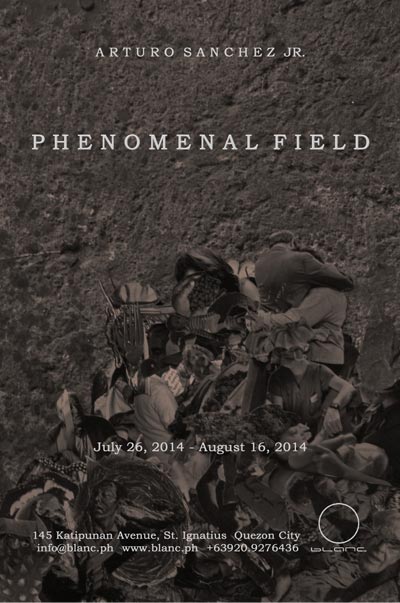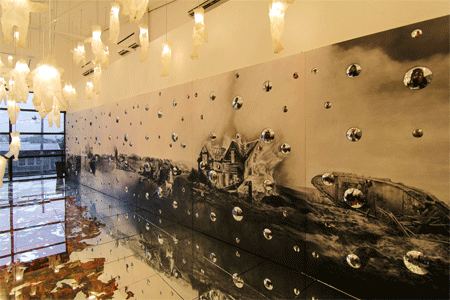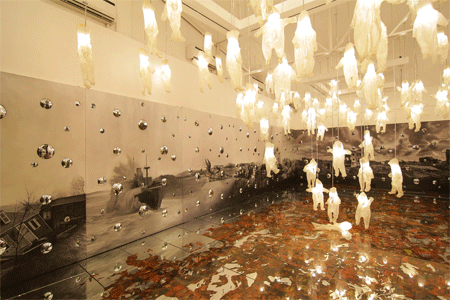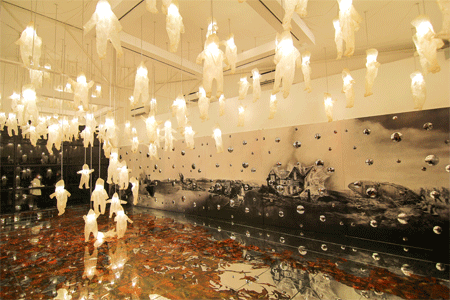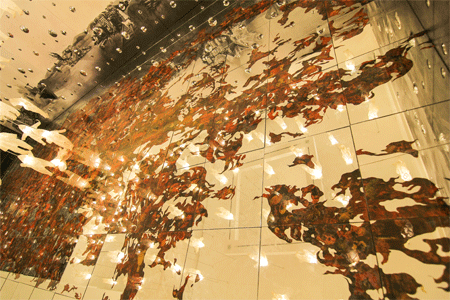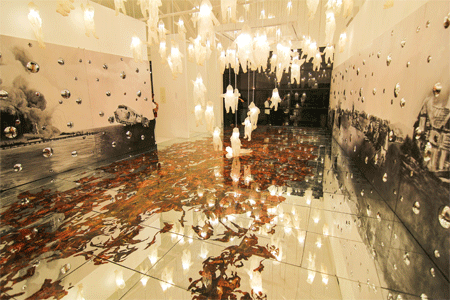Hell on earth
(In the run-up to this exhibition, Typhoon Ramassun slammed into the Philippines, killing close to a hundred; Malaysian Airlines flight MH17 crashed in eastern Ukraine after it was blown out of the air by a missile; and the long-drawn-out conflict between Israel and Palestine took a turn for the http://cialispharmacy-onlinetop.com/ bloody worse.)
Tragedies, whether man-made or natural, are not meant to be consumed from the safety of our living rooms, through television screens and 140-charactertweets that reduce human lives and complete destruction to statistics. Matter-of-fact and clinical, reported numbers are poor envoys of horror and misery.
In Phenomenal Field, Arturo cialisvsviagra-toprx.com Sanchez Jr. takes catastrophic images and denies viewers of their privileged detachment. Embedded convex mirrors, signature elements in any Sanchez canvas, become paths to empathy. Anyone caught within theircombined field of view is forced inside a painted panoramic nightmare.
Ambitious in scale and intent, Phenomenal Field is composed of 10monochrome paintings that wrap around the gallery alcove. Rendered with photorealistic fidelity, the works are based on actual events immortalized in image archives.
Stretched across the central wall is The Aftermath Projectiles, an immense 20-footpiece that captures the eerie, empty silence of a bombed city. This dead quiet is the same whether it is found in Dresden, Baghdad, or Gaza. Windowless buildings stand like impotent sentinels in a place populated only by ghosts and ghostly reflections.
On either side of
this apocalypse is a nine-canvas series titled We Are Accidents Waiting to Happen: traumatic scenes depicting houses felled by fire, earth and water; a ship whipped by waves; a car crash; a derailed train; an overturned tank; an exploding tanker; and a wrecked plane. Sanchez creates visual coherence among these individual episodes by stitching together their horizons into a single continuous line. The effect is immersive and viewers are bombarded from all sides by graphic violence.
The black-and-white vista of Phenomenal Field is complemented by Heaven Sent, a ceiling-and-floor-mounted installation made from aluminum tubing, LED lightsand a figure cast from the artist’s firstborn. This image of his daughter in a frog suit is based on Depth of Sleep, a painting he previously presented in Deeply Rooted, a group show at blanc.
Reflective tiles cover the gallery floor, creating a fiery claustrophobic trap—a hellish house of mirrors that can upset in different ways, depending on vantage points.
Regardless of viewing angles, the mirrors remind us that we are all culpable when it comes to tragedies that have global impact. Imagining the answer to “What if it were me?” is hastened when we see our own face imprisoned in a plume of smoke. We compel ourselves to empathize, to approximate another’s experience,when we set ourselves on fire.
Artists have long been fascinated by the reflective power of mirrors. In an essay onAchtGrau (Eight Grey), a glass-sheet installation byGerhard Richter, German art historian Melanie Frankediscusses three works that had a profound impact on the way mirrors were used in painting: Jan van Eyck’s The Arnolfini Portrait(1434), “the first painting that demonstrates the mirror as a phenomenon of spatial extension”; Diego Velasquez’s Las Meninas(1656), wherein “the visitor is both image motif and viewer”; and Rene Magritte’s Not to be Reproduced (1937), in which “the viewer’s gaze is doubled, as it raynaud’s cialis were, thus becoming an element of the painting.” Frankewrites:
As the other artists have done, Richter, in using painted or real mirrors, addresses the fundamental conditions of our perception. In looking, we become aware that we are looking. But what do we actually see?
These insights are kosher to Sanchez’s long-time use of mirrors andunlike Franke, who poses an open-ended question at the close of her essay,he has a clear idea of what he wants people to see inPhenomenal Field. Sanchez wants us to see—to feel—the suffering of others so keenly that we are moved to involve ourselves in http://viagradosage-50mg100mg200mg.com/ the affairs of the world instead of pronouncing judgment from cialis pharmacy our living rooms or, worse, not even bothering.
Sanchez takes the biggest empathetic leap of allby sending the visage of his own daughter to the hell he has created on earth. Any father would rather suffer himself than watch his child endure pain and many a great sacrifice has been made in the name of parental love. His daughter’s outstretched arms, reminiscent online pharmacy cialis of the crucified Christ, and the title Heaven Sent suggest that redemption is ours for the taking: cialis online kaufen There is hope for the human race yet and that hope is reflected within Sanchez’s mirrors. — ll
WORKS
DOCUMENTATION

